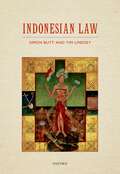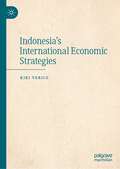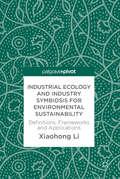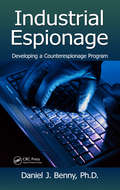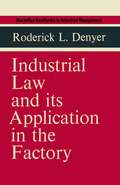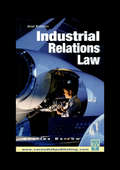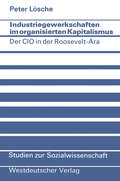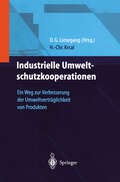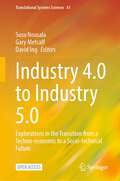- Table View
- List View
Indonesian Law
by Simon Butt Tim LindseyIndonesia has a growing population of almost 300 million people, it is increasingly involved in world affairs, and has a booming economy. The need to better understand its unique, complex, and often obscure legal system, has become pressing. This is true across a wide range of sectors including, but not limited to, trade and investment, crime and terrorism, and human rights. Indonesia's democratization after the fall of Soeharto in 1998 triggered massive social and political changes that opened up this diverse, and formerly tightly-controlled, society. Law reform was a key driver of Indonesia's transformation and its full effect remains to be seen. This book offers clear and detailed explanations of the foundations of Indonesia's legal system in the context of its legal reform and rapid development. It offers succinct commentaries on a wide range of issues, examining the judicial process, the constitution, corruption and the court system, contract law, administrative law, foreign investment, taxation, Islamic law, and family law. It examines current substantive law and judicial interpretation and presents case studies of how the system operates in practice. Written in an accessible and engaging style, this book is an essential guide for readers seeking quick and clear answers to questions regarding the law and its application in Indonesia.
Indonesian Law
by Tim Lindsey Simon ButtIndonesia has a growing population of almost 300 million people, it is increasingly involved in world affairs, and has a booming economy. The need to better understand its unique, complex, and often obscure legal system, has become pressing. This is true across a wide range of sectors including, but not limited to, trade and investment, crime and terrorism, and human rights. Indonesia's democratization after the fall of Soeharto in 1998 triggered massive social and political changes that opened up this diverse, and formerly tightly-controlled, society. Law reform was a key driver of Indonesia's transformation and its full effect remains to be seen. This book offers clear and detailed explanations of the foundations of Indonesia's legal system in the context of its legal reform and rapid development. It offers succinct commentaries on a wide range of issues, examining the judicial process, the constitution, corruption and the court system, contract law, administrative law, foreign investment, taxation, Islamic law, and family law. It examines current substantive law and judicial interpretation and presents case studies of how the system operates in practice. Written in an accessible and engaging style, this book is an essential guide for readers seeking quick and clear answers to questions regarding the law and its application in Indonesia.
Indonesian Private International Law (Studies in Private International Law - Asia)
by Afifah KusumadaraThis book is the leading reference on Indonesian private international law in English. The chapters systematically cover the whole of Indonesian private international law including commercial matters, family law, succession, cross-border insolvency, intellectual property, competition (antitrust), and environmental disputes. The chapters do not merely cover the traditional conflict of law areas of jurisdiction, applicable law (choice of law), and enforcement. The chapters also look into conflict of law questions arising in arbitration and assess Indonesian involvement in the harmonisation of private international law globally and regionally within ASEAN. Similarly to the other volumes in the Studies in Private International Law - Asia series, this book presents the Indonesian conflict of laws through a combination of common and civil law analytical techniques and perspectives, providing readers worldwide with a more profound and comprehensive understanding of the subject.
Indonesia’s Delimited Maritime Boundaries
by Vivian Louis ForbesThis book examines the delimited maritime boundaries of Indonesia with its neighbours. It features carefully drawn maps based on the geographical coordinates of the defined maritime boundaries; the reproduction of a complete set of the primary documents with direct relation to the boundaries; and a comprehensive narrative on the geography and the historical development of the archipelagic State. Indonesia has an immense maritime domain that encompasses much of the sea between Australia and the Asian mainland. In addition, Indonesia is itself made up largely of water: in excess of 17,000 islands, Indonesia’s archipelagic and territorial waters together form about three-fifths of the country’s sovereign territory. This book offers readers clear, accessible information on the maritime boundaries of the world’s largest archipelagic state.
Indonesia's International Economic Strategies
by Kiki VericoThis book discusses Indonesia's international economic strategies. It examines unilateral aspects, foreign direct investments, bilateral economic relations, regional elements, ASEAN's role, and the Indo-Pacific's dynamic frameworks. Starting at the unilateral level, the book outlines how Indonesia managed its macro-economy to recover quickly and adequately from 2020 to 2021 amidst the global COVID-19 pandemic. It argues that Indonesia needs an open economic principle to enhance trade and investment relations. In addition, the book elaborates on how Indonesia transforms its economy with export-oriented long-run investment (Foreign Direct Investment) inflows as a necessary condition for economic transformation as it fits with Indonesia's manufacturing sector, which is critical to the country. Further, the book thoroughly explains Indonesia's bilateral economic relations, from its production networks with Indonesia's major partners to their impacts. It highlights the products which will provide enormous potential benefits for the country. The book also covers regional and mega-regional aspects of Indonesia's economy. Focusing on the Association of Southeast Asian Nations (ASEAN), it emphasises the regional organisation's three essential principles for economic integration: openness, convergence, and inclusiveness. In doing so, research in the book also includes perspectives on how ASEAN sees Asia and the Indo-Pacific framework. It also argues that ASEAN needs centrality in enlarging its economic cooperation with other countries or regions and how a member state's unilateral and bilateral liberalisation are building blocks for ASEAN.
Industrial and Medical Nuclear Accidents: Environmental, Ecological, Health and Socio-economic Consequences
by Jean-Claude AmiardThe peaceful use of atomic energy has given rise to a variety of nuclear accidents from the start. This concerns all forms of use, industrial and medical. For each accident, Industrial and Medical Nuclear Accidents details the contamination of the environment, flora and fauna, and quantifies the effects of ionizing radiation. The book also examines the adverse effects on the health, both physical and mental, of the human populations concerned. The monetary cost is also evaluated. The research presented in this book is based on scientifically recognized publications and on the reports of national and international organizations competent in this field (IAEA, WHO, UNSCEAR, IRSN, etc.). The book contains chapters devoted to the most recent accidents (Chernobyl and Fukushima), with a large body of institutional and academic literature.
Industrial and Medical Nuclear Accidents: Environmental, Ecological, Health and Socio-economic Consequences
by Jean-Claude AmiardThe peaceful use of atomic energy has given rise to a variety of nuclear accidents from the start. This concerns all forms of use, industrial and medical. For each accident, Industrial and Medical Nuclear Accidents details the contamination of the environment, flora and fauna, and quantifies the effects of ionizing radiation. The book also examines the adverse effects on the health, both physical and mental, of the human populations concerned. The monetary cost is also evaluated. The research presented in this book is based on scientifically recognized publications and on the reports of national and international organizations competent in this field (IAEA, WHO, UNSCEAR, IRSN, etc.). The book contains chapters devoted to the most recent accidents (Chernobyl and Fukushima), with a large body of institutional and academic literature.
Industrial Design Rights: An International Perspective
by Brian W. GrayThis book is a revised and updated edition of a major work first published in 2001 under the auspices of the Intellectual Property Committee of the International Bar Association. As a comparative cross-jurisdictional analysis of the practice, theory, scope, and types of design protection, it will continue to be of immeasurable value to lawyers and others involved in industrial design. Industrial designs are particularly interesting because the laws in many countries attempt in different ways to find a balance between protection for the artistic creation and the freedom to use the purely functional, and between the proprietary rights of the creator and the public domain rights of the competitor. The third edition is comprised of twenty-five country reports, each written by one or more prominent intellectual property lawyer(s) in the country covered. To facilitate cross-jurisdictional comparison, each report is structured according to the following sequence of topics: new developments in each jurisdiction; conventions and legislation; definition of what constitutes a protectable design; originality /novelty; duration of protection; infringement; defences to infringement; procedures for filing application for registration; and expunging, cancelling, or varying registration. Prominent new developments covered in the third edition include new chapters from South Korea, Russia and Turkey as well as continuing coverage of the impact of the European Community Design Directive, the adoption of the Hague Agreement with corresponding major changes to US and Canadian design law and practice, the newly revised Japanese Design Law, and China’s revised Guidelines for Examination. Each jurisdiction’s currently applicable legislation, regulation, and case law is summarized and analysed.
Industrial Ecology and Industry Symbiosis for Environmental Sustainability: Definitions, Frameworks and Applications
by Xiaohong LiThis book opens up a critical dimension to the interdisciplinary field of Industrial Ecology (IE) and one of its four areas - Industrial Symbiosis (IS). Presenting the concept of closed-loop thinking, this timely book explains how industries and societies can achieve environmental sustainability, a necessity for today’s businesses. Providing a critical review of the definitions and developments of both IE and IS, this study establishes their fundamental role in improving environmental sustainability. The author identifies valuable lessons to be learned and presents conceptual frameworks to guide future IE and IS applications. Transforming industrial systems into closed-loop industrial ecosystems dramatically reduces the negative impact of industrial activities on the environment. Therefore, this book is an important read not only for operations management scholars, but also those who are interested in ensuring an environmentally sustainable future.
Industrial Ecology and Industry Symbiosis for Environmental Sustainability: Definitions, Frameworks and Applications
by Xiaohong LiThis book opens up a critical dimension to the interdisciplinary field of Industrial Ecology (IE) and one of its four areas - Industrial Symbiosis (IS). Presenting the concept of closed-loop thinking, this timely book explains how industries and societies can achieve environmental sustainability, a necessity for today’s businesses. Providing a critical review of the definitions and developments of both IE and IS, this study establishes their fundamental role in improving environmental sustainability. The author identifies valuable lessons to be learned and presents conceptual frameworks to guide future IE and IS applications. Transforming industrial systems into closed-loop industrial ecosystems dramatically reduces the negative impact of industrial activities on the environment. Therefore, this book is an important read not only for operations management scholars, but also those who are interested in ensuring an environmentally sustainable future.
Industrial Espionage: Developing a Counterespionage Program
by Daniel J. BennyThe FBI estimates that billions of U.S. dollars are lost each year to foreign and domestic competitors who deliberately target industrial trade secrets. And, although today‘s organizations face unprecedented threats to the security of their proprietary information and assets, most books on industrial espionage fail to supply guidelines for establis
Industrial Hygiene: Improving Worker Health through an Operational Risk Approach (Sustainable Improvements in Environment Safety and Health)
by Frances Alston Emily J. Millikin Willie PiispanenOver the past forty years, the Industrial Hygiene profession has significantly grown, and is expected to continue to grow as workplaces evolve in the development, management, and usage of hazardous materials. This growth in the profession is also related to the shift in public knowledge and perception regarding the acceptance of the health risk from activities performed at work and home. As time progresses, workplaces are being regulated to not only minimize the health imparts to the workforce, but also decrease the likelihood of negatively impacting the environment. Society has become more educated on the potential impacts on human health and the environment that hazardous materials, activities, and environments can pose. As such, there has been a noticeable decrease in the acceptance of risk by workers and the public. The accepted standard of performance for Industrial Hygiene has grown beyond compliance, but now also focuses on improving existing processes and practices to create a workplace free from work related injury and illness. Features: Shows application of risk mitigating techniques for industrial hygienists Explains the definition of risk and how it applies to health and safety management Defines the need for quality data management and continuous improvement in assessments Describes the role of the Industrial Hygienist and risk management when responding to emergencies Industrial Hygiene: Improving Worker Health through an Operational Risk Approach focuses on the implementation of Industrial Hygiene, using a risk-based approach, in an operational environment. The approaches and methods described in this book are designed to assist the Industrial Hygienist in managing workplace risks, including risks associated with anticipation, recognition, evaluation, and hazard control processes.
Industrial Hygiene: Improving Worker Health through an Operational Risk Approach (Sustainable Improvements in Environment Safety and Health)
by Frances Alston Emily J. Millikin Willie PiispanenOver the past forty years, the Industrial Hygiene profession has significantly grown, and is expected to continue to grow as workplaces evolve in the development, management, and usage of hazardous materials. This growth in the profession is also related to the shift in public knowledge and perception regarding the acceptance of the health risk from activities performed at work and home. As time progresses, workplaces are being regulated to not only minimize the health imparts to the workforce, but also decrease the likelihood of negatively impacting the environment. Society has become more educated on the potential impacts on human health and the environment that hazardous materials, activities, and environments can pose. As such, there has been a noticeable decrease in the acceptance of risk by workers and the public. The accepted standard of performance for Industrial Hygiene has grown beyond compliance, but now also focuses on improving existing processes and practices to create a workplace free from work related injury and illness. Features: Shows application of risk mitigating techniques for industrial hygienists Explains the definition of risk and how it applies to health and safety management Defines the need for quality data management and continuous improvement in assessments Describes the role of the Industrial Hygienist and risk management when responding to emergencies Industrial Hygiene: Improving Worker Health through an Operational Risk Approach focuses on the implementation of Industrial Hygiene, using a risk-based approach, in an operational environment. The approaches and methods described in this book are designed to assist the Industrial Hygienist in managing workplace risks, including risks associated with anticipation, recognition, evaluation, and hazard control processes.
Industrial Law and Its Applications in the Factory (Industrial Relations in Practice Series)
by R.L. DenyerIndustrial Relations Law
by Charles Barrow"First Published in 2002, Routledge is an imprint of Taylor & Francis, an informa company."
Industrial Relations Law
by Charles Barrow"First Published in 2002, Routledge is an imprint of Taylor & Francis, an informa company."
Industrial Safety and Health for Administrative Services
by Charles D. ReeseIndustrial Safety and Health for Administrative Services constitutes a much-needed source for the identification and prevention of most of the injuries and illnesses occurring in the financial and information sectors. The text thoroughly explains the issues of office health management, major safety and electrical hazards, and emergency response to
Industrial Safety and Health for Goods and Materials Services
by Charles D. ReeseIndustrial Safety and Health for Goods and Materials Services focuses on the safety requirements of the wholesale and retail trades, including warehousing. This detailed text describes the hazards associated with chemicals, compressed gases, and fire. In addition to discussing the ergonomics behind hand tools, ladders, machine guarding, material ha
Industrial Safety and Health for Infrastructure Services
by Charles D. ReeseIndustrial Safety and Health for Infrastructure Services provides an in-depth look into the areas of transportation, utilities, administrative, waste management, and remediation. It covers OSHA regulations in reference to the major safety and health hazards associated within these five fields. This user-friendly text:Provides guidance on removal, d
Industrial Safety and Health for People-Oriented Services
by Charles D. ReeseIndustrial Safety and Health for People-Oriented Services focuses on the safety requirements of the tertiary sector of industry's education, health, and hospitality services. This is an instruction manual on managing a safe and healthy environment- one free of biological, chemical, and ergonomics hazards - while adhering to OSHA regulations. In add
Industriegewerkschaften im organisierten Kapitalismus: Der CIO in der Roosevelt-Ära (Studien zur Sozialwissenschaft #29)
by Peter LöscheIndustrielle Umweltschutzkooperationen: Ein Weg zur Verbesserung der Umweltverträglichkeit von Produkten
by Hans-Christian KrcalIndustry 4.0 to Industry 5.0: Explorations in the Transition from a Techno-economic to a Socio-technical Future (Translational Systems Sciences #41)
by Susu Nousala Gary Metcalf David IngThis is an Open Access book.In 2015, Industry 4.0 was announced with the rise of industrialization by the European Parliament, supporting policy, research, and infrastructure funding. In 2020, Industry 5.0 was launched as an evolution of Industry 4.0, towards societal and ecological values in a sustainable, human-centric, and resilient transition. In 2023, the IN4ACT research project team completed 4 years of research on the impact on these initiatives.Presentations reviewing the progress of management practices and economics led to conversations about what’s next. The unanticipated rise in late 2022 of Generative AI technologies (e.g. ChatGPT, DALL-E) sparked dialogues with an extended circle of researchers on impacts not considered in 2015 or in 2020. This collection of chapters reflects multiple perspectives on research findings to 2023, prospects for 2024, and considerations on ways the techno-economic industrial revolutions may be reshaped into desirable futures respecting social and ecological concerns.
Industry and Civilisation (Routledge Revivals)
by C. Delisle BurnsOriginally published in 1925, Industry and Civilisation explores moral standards and ethics related to economic activities by providing a comprehensive view of psychological data obtained from the business world. As well as exploring general ethics and psychology, this work also focusses on the principles underlying economic legislation and how this impacted on moral standards of the time. This title will be of interest to students of Business and Economics.
Industry and Civilisation (Routledge Revivals)
by C. Delisle BurnsOriginally published in 1925, Industry and Civilisation explores moral standards and ethics related to economic activities by providing a comprehensive view of psychological data obtained from the business world. As well as exploring general ethics and psychology, this work also focusses on the principles underlying economic legislation and how this impacted on moral standards of the time. This title will be of interest to students of Business and Economics.
